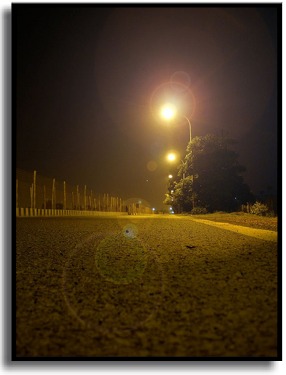Posted by Nicky Drayden on Apr 23, 2010 in
Writer's Life So speaking of world building, Basic Instructions has this tidbit of advice about how to explain a fictional technology or superpower.
There’s definitely a balance to it: too little and you’ll leave your readers confused or distracted from the story. Too much, and they’ll be digging through a tech manual for plot and characters. Though I do admit, world building is fun to get lost in, especially when you’re trying to procrastinate on writing your actual novel. But it’s important to remember that not every piece of world building needs to end up in the book. In fiction, like in life, there is such a thing as TMI.
Tags: comedic, fantasy, science fiction, world building
Posted by Nicky Drayden on Apr 17, 2010 in
Reviews Author Website: www.jlake.com
Published by: Clarkesworld Magazine, February 2010
 Photo by Rick Creative Commons
Photo by Rick Creative Commons
The Story:
Engineering Supervisor Domitian Spanich is always falling for the wrong type of guy — the young, pretty kind who don’t stick around once they’ve spent his pay chitty on fancy drinks. Half the guys torquing vacuum on Estacada Orbital swing his way, and yet Spanich finds himself hopelessly captivated by Austen, Spanich’s dull-witted sometimes lover, whose finer attributes include a tight body, crooked smile, and violet eyes. But then Austen shows unexpected interest in Mare Imbrium {13 pairs}, the starship Spanich had been working on for three straight shifts, and Spanich’s world changes overnight.
The Craft: World Building
SPOILERS
Torquing Vacuum has a lot going on world building wise, and yet it’s all integrated into the story in a way that doesn’t leave the reader’s head spinning. (Though I do admit, I had to print this one out so I could better digest it.) Immediately the world feels foreign, right from the mention of Spanich’s name (pronounced Span-ick, or Spinach if you really want to piss him off.) We quickly learn that Spanich is a drive tech on Estacada Orbital. He’s working on a ship, the Mare Imbrium {13 pairs}, which has a shipmind — a bit of world building that really stands out in this piece. Here, the shipminds aren’t subservient as they are in so many science fiction stories, but revered and their ship’s names demand respect, like the credentials of a honored official.
The ambiance of Estacada Orbital is set with a mix of tech and culture, introduced with conflicts related to the story. We learn of the monetary system through Austen’s frivolous spending of Spanich’s pay chitty, local thalers, and Imperial schillings, the latter of which also hints at the greater political structure of this universe. The cybernetic waiter at the bar seems like it’s just as likely to kill Spanich as it is to serve him a drink, which suggests that Estacada Orbital is the kind of place where you watch your back. The colloquialisms also add a touch of charm, like: “Thank the pressure demons this place was so dark.” and I particularly enjoyed the line about how “Austen could scent ‘broke’ the way a sniffer could find a carbon dioxide breach in a scrubber tank.”
We’re also given a broader view of the universe with mentions of the Mistake, an event that is never explained, but its effects weigh heavily on the story in the form of genetically altered humans. The glimpse of the Imperial family is a small one, but is also very telling. Watching Spanich’s reaction as he realizes who Austen really is gives us insight into the hierarchy and ruling class, though their interaction is of a personal nature rather than political. Overall, this story gives the reader a lot to chew on, but it’s presented in manageable chunks. The details of the world are specific and fun and are worked into the story in a natural, tidy, entertaining way.
Tags: Clarkesworld, queer fiction, science fiction, space opera, world building
Posted by Nicky Drayden on Apr 12, 2010 in
Reviews Published by: Chizine, 2010
 Photo by Dipanker Dutta Creative Commons
Photo by Dipanker Dutta Creative Commons
The Story:
There was a time, not long ago, when humans ruled the Earth. But all that’s disappeared, along with those people who didn’t accept their new lot in life and went out looking for answers, never to be seen again. The night rules now, and the dark will get you if you aren’t careful. The night never comes into houses though, so people huddle together, cramming into living rooms, bedrooms, wherever there’s space. Windows are papered shut so the darkness won’t seep inside. There’s some semblance of safety in the light, and for two young women, the thrill of venturing out past curfew, jumping between the pools of yellow light cast by streetlamps is too much to resist.
The Craft: World Building
SPOILERS
The Year of the Rabbit is an interesting example of world building, because the world is not built with description but with fear and the characters’ reaction to fear. The story starts with streetlamps, or more importantly, the light they emit at night, keeping the dark away. We quickly learn that the night is not safe. The reader doesn’t get a clear sense of what’s going on in the opening scene, but we do know that we should be afraid. The word cues are subtle, but there: “drowning in the dark”, “lights started dying”, “illusion of safety”, “swarming ocean of black”. It’s clear these characters have diverged from our world and have journeyed into one of their own.
In the next few scenes, we get a sense of what life is like for these people now that humanity has been thrown from the driver’s seat. No longer in control, they hide from the night, drawing strength in numbers, and using each other for warmth in the winter months. The electricity and water are gone, but they make do. And curiously, there’s always food waiting for them, though no one tends the store. No one asks where the food is coming from. Curiosity is what’ll get you snatched up by the night, like all those others who went searching for answers and never came back. There’s something otherworldly going on here, and just when the reader is starting to get uncomfortable, the author strikes at our childhood fears:
“Night never came into the houses. It was the same way that kids’ monsters never crawled under their blankets and never reached over the side of their beds.”
The world expands some in the following scenes, and we get a glimpse of the park and the city and the streets. The park is so full of light, that even the shadows look friendly, but by now, the reader knows better. The city has been picked clean, wooden garages torn down for firewood, abandoned houses scavenged for blankets and food. And the streets are dark and too quiet, with streetlamps flickering in and out like the dark is trying to catch you.
Year of the Rabbit tempts the reader to dangle her feet into the mysterious shadows, and the thrill of the story is well worth it. Wonderfully written, intriguing, and poignant, this story will take you to another world constructed from the fear within.
Tags: Chizine, dark, literary, world building


